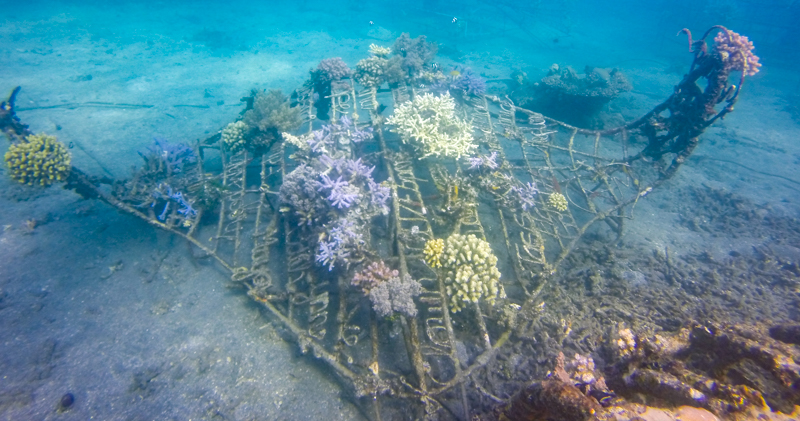Last week we had the opportunity to dive the North West coast of Bali. We did two spectacular wall dives off Menjangan Island and visited the Bio-Rock reef project in Permuteran Bay.

First up Menjangan Island is located 5km (3 miles) off shore from Bali, it is a popular diving destination and inside a national park so the reefs are supposed to some of the best in the region. The small island is surrounded by a shallow corals reef 3m (10 feet) which drop off quickly to a reef wall down to 30m (100 feet).
The wall is covered in sponges, sea fans, and dendronephthya, we also found big clusters of clove polyps and even a branching form of clove polyp. We found a big colony of Blastomussa, a crop circle of Fungia fralinae, encrusting and plating montipora, and branching porites, however we found less Acropora on the wall that we did on top.

For the second dive we headed to the north side of the island to a dive spot called the coral garden. We had over a one hour surface interval and we took the opportunity to snorkel the shallow reefs. We were disappointed to see dozens of large crown of thorn starfish on the reef, and less Acropora suharsonoi than on previous dives in the area.
Nevertheless the shallows well full of fish, clams and large boulders of porites corals and we could have spent plenty more time searching around for little hidden treasures. One word of caution, while snorkeling Menjangan our host Vincent came across a rather nasty Titan trigger fish which will actively defend their nest. This shouldn’t stop you from snorkeling, however just keep an eye out in the blue for a Titan which may be coming your way!

Overall we enjoyed the big schools of fish, and lush stands of sarcophyton corals at Menjangan Island, the shallow reefs at the top of the wall made for the perfect safety stop and we easily spent 20 minutes diving at 5m (16 feet) at the end of each dive just because there was so much to see.
From the feedback we got from other divers on the boat (who have been to Manjangan before) the reef is not looking as good as it used to. This is perhaps do to the crown of thorns, damage caused by storms or something we cannot predict but it got us thinking about what we could do as aquarist to help imbue our coral growing skillset to help replant the damaged reefs, hopefully more to come on this in the future.
If you couldn’t already tell we have a soft spot for corals, and especially various restoration project around the globe. The Indonesian coastline is a perfect place to explore this topic as they have a long history of reef restoration.

The Biorock project in Permuteran Bay started in the year 2000, and as with many of the similar projects in Indonesia, grew from a desire from local fisherman with help from NGO organizations as a project to restores damaged reefs cause by blast fishing and cyanide poisoning. What sets the Bio-Rock project apart is the use of Electrolytic Mineral Accretion Technology, creating the Bio-Rock system.
Bio-Rock technology uses a low voltage current produced by solar panels, which travels in cables from the surface and is then hooked up to the metal frames of the Bio-Rock structures. By passing the current through seawater, this causes dissolved minerals to crystallize forming structures similar to limestone where coral larvae can more easily settle and grow.

Since the projects inception in 2000 over sixty Bio-Rock structures have been installed. Tourists have the opportunity to donate to the project where they can sponsor a coral or their own coral frame. The site is easily accessible from the beach and many of the structures are within a few meters of the surface at a perfect depth for snorkeling or for divers with less experience who may not be able to dive the deeper walls of Menjangan Island.
We were impressed with the diversity of Acropora corals at Permuteran and really felt like getting in on some of the action, fragging and planting some new corals! Maybe next time 🙂



